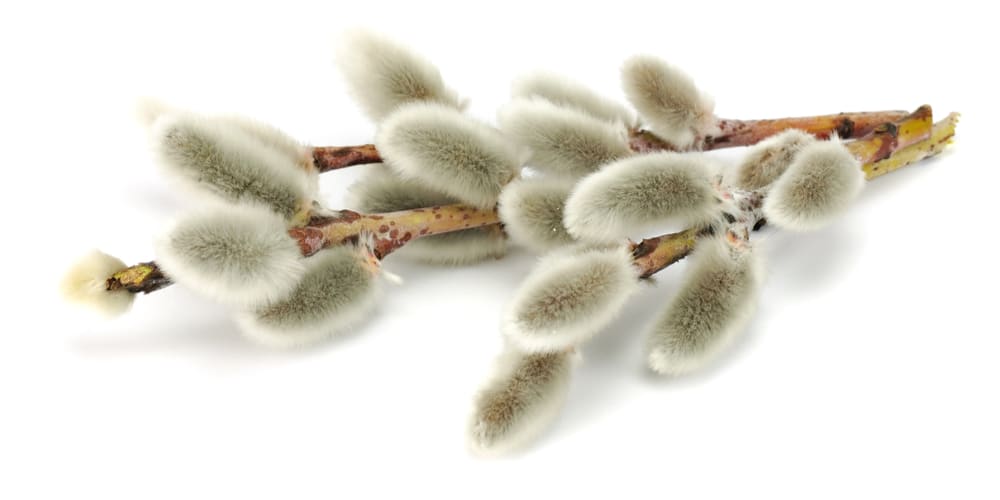Purist signs of spring. These delicate flowers emerge from their winter hibernation, poking through the cold ground with a promise of warmer days.
Additionally, this plant is a welcome sight after months of barrenness, and its arrival is often celebrated with great enthusiasm. The soft, fuzzy buds of pussy willows are irresistible to young children who often use them as tickle sticks or decorate their homes with bouquets of the fragrant blossoms.
What are Pussy Willows?
Pussy Willows is a type of tree that belongs to the genus Salix. There are over 200 species of Salix, but only a handful of them produce the characteristic fuzzy buds that have made the plant so popular.
The plant typically grows between 6 and 25 feet tall, with slender branches and silvery-grey leaves. The flowers are usually yellow or white and bloom in early spring. Pussy Willows are often used in floral arrangements, as they add a touch of whimsy and charm.
Near water sources, such as creeks or rivers, is the most ideal place to grow the plant. They can also grow in damp, marshy areas. It needs these habitats because its roots require moist soil to grow.
Where Do Pussy Willows Grow
Pussy willows are found in many parts of the world, like North America, Europe, and China. In North America, pussy willows are found in almost every US state except Hawaii.
They’re especially common in the Northeast and Midwest regions of the country, where the climate is more relaxed, and the winters are long.
They are most commonly found in the Northeast and Midwest regions, the Pacific Northwest, and parts of the South.
Pussy Willows Varieties
There are many different types of pussy willows which include:
Salix Discolor
Salix discolor, also known as the American Pussy Willow, is a species of willow native to North America. It is hardy in USDA zones 4-8, which means it can withstand temperatures as low as -30°F.
The tree grows to a height of 20-30 feet and has a distinctive appearance, with bright green leaves and yellowish-brown branches.
The leaves are lance-shaped and measure 2-5 inches long. The flowers are small and round, with fuzzy white petals resembling a cat’s fur. The fruit is a small capsule containing black seeds.
Additionally, it is often used as an ornamental tree in parks and gardens. It is also grown for its wood, which is used to manufacture baskets and other objects.
Salix Caprea
The Salix Caprea, commonly known as the Goat Willow, is a willow native to Europe in regions like Britain and Norway. It is a tree that typically grows to 15-25 feet tall, with a dense, rounded crown and crooked, yellow-brown branches.
The leaves are alternate, lance-shaped, 2-5 inches long, with a silky-hairy surface and a pointed tip. The flowers are tiny and emerge in early spring before the leaves. They grow in long, pendulous catkins, which give the tree its characteristic “pussy” appearance.
This variety is widely used as an ornamental tree in gardens and parks. Its branches are often used in floral arrangements.
Salix Babylonica
The Salix babylonica, also known as the weeping willow, is a willow native to Northern China. As its name suggests, it is characterized by its long, drooping branches. The leaves are lanced-shaped like the other varieties, and the bark is smooth and gray.
Moreover, this makes it a famous ornamental tree. It has been introduced to many regions outside of its native range.
Salix Cinerea
The Salix Cinerea, also known as the Grey Willow, is a tree native to Europe in places like England. It has narrow, lance-shaped leaves covered in a dense mat of soft, downy hairs.
The flowers are tiny and inconspicuous, but the plant is most recognizable for its furry, silver-grey buds. These eventually mature into the characteristic ‘pussy willow’ catkins, which give the plant its common name.
The Salix Cinerea is a popular ornamental plant often used in floral arrangements. At the same time, it is also a food source for some birds and small mammals.
Where Do Pussy Willows Grow: Final Thoughts
Pussy Willows grow near water sources, such as creeks or rivers, and they can also grow in damp, marshy areas. They are found in many parts of the United States but most commonly in the Northeast and Midwest regions.
There are many different types of pussy willows which include Salix Discolor, Salix Caprea, and Salix Babylonica, to name a few.

